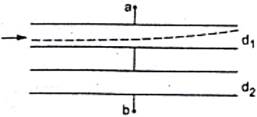Both the capacitors shown in figure are made of square plates of edge a. The separations between the plates of the capacitors are d1 and d2 as shown in the figure. A potential difference V is applied between the points a and b. An electron is projected between the plates of the upper capacitor along the central line. With what minimum speed should the electron be projected so that it does not collide with any plate? Consider only the electric forces.

Given,
d1,d2 are the separations between capacitor plates in the upper and lower capacitors respectively.
a is the length of each plate
Area of each plates![]() a2
a2
Sy is the distance that the electron must travel in order to avoid collision in Y-direction![]() d1/2
d1/2
Sx is the distance that the electron must travel in order to avoid collision in X-direction![]() a
a
V is the potential difference between the given series arrangement of capacitors.
e is the charge of electron released in between the plates
Formula used
In order to avoid a collision with plates, the electron should have an initial velocity, v. Hence, with ‘v’ velocity, the electron should travel a distance of ‘d1/2’ in Y-direction and ‘a’ in X-direction

Since the electric field is acting only in Y-direction, the electron will travel with constant velocity, v, in X-direction.
Hene the external force, neglecting gravitational and other forces, acting on the electron is the force due to the electric fieldqE). Hence, according to Newton’s second law of motion, we can write,
![]()
![]()
Where,
m![]() mass of electron;
mass of electron;
ay![]() acceleration of electron in Y-direction;
acceleration of electron in Y-direction;
q=e=charge of electron;
E= Magnitude of Electric field acting between the plates of capacitor.
We know that the distance that must be traveled in X-direction![]() a
a
So, by the equations of motion, this can be represented as,
![]()
Or,
![]()
Where,
t![]() time taken to travel ‘a’ distance
time taken to travel ‘a’ distance
Acceleration in X-direction is Zero)
And the distance that must be traveled in Y-direction![]() d1/2
d1/2
Hence, by the equation of motion, assuming no initial velocity in Y-direction as the electron is projected horizontally.
![]()
From eqn.1 and eqn.2, eqn. 3 can be modified as,
![]()
Now, let C1 and C2 be the capacitance of the upper and lower capacitors. Hence the effective capacitance, Ceff of the series arrangement is,
![]()
Or,
![]()
Where,
![]() and
and ![]()
ε0![]() Permittivity of free space, in between the capacitor plates.
Permittivity of free space, in between the capacitor plates.
Hence,

Or,
![]()
Now, the magnitude of electric field, E, in the upper capacitor is given by,
![]()
Where, V1![]() Potential difference in the upper capacitor and is equal to,
Potential difference in the upper capacitor and is equal to,
![]()
Where,
Q= charge in each capacitor ![]() total charge in the arrangement, since it is a series arrangement
total charge in the arrangement, since it is a series arrangement
Hence, Q can be calculated as,
![]()
Where V![]() total potential difference
total potential difference
Or,
![]()
Substituting the above equation and the value of C1 in eqn.6, we get,

Or,
![]()
Substituting the above expression in eqn.5, we get,

Or,
![]()
Substituting the above expression in eqn.4, we get

By re-arranging,

The above expression is the least value of horizontal initial velocity needed for the electron to cross the capacitor plates without collision.